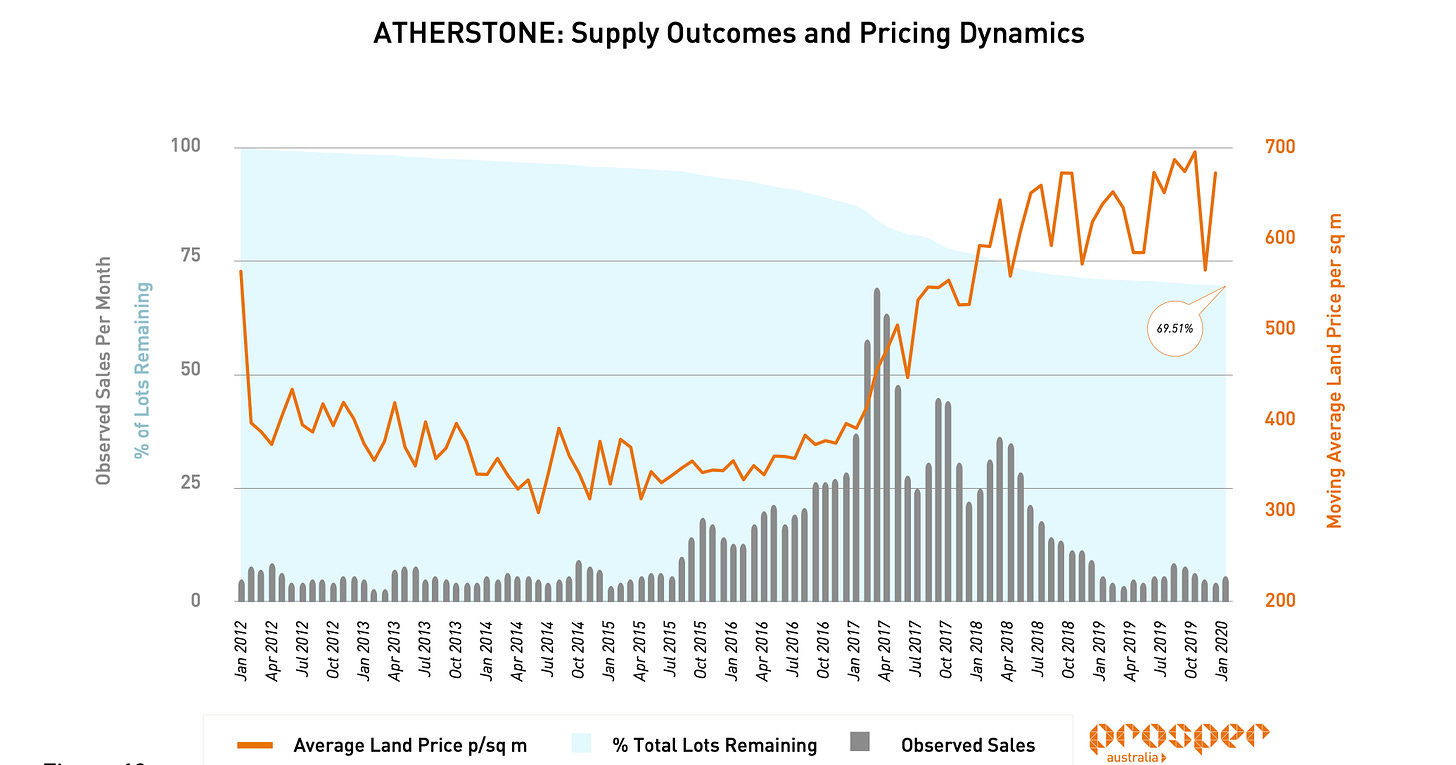The practice of ‘land banking’ refers to the staged release of land by property developers in order to maximise their profits.
Unbelievably, the National Housing Finance & Investment Corporation (NHFIC) has played down concerns that land banking holds back supply and pushes up house prices, presumably because it does not fit the narrative that Australia’s housing shortage is driven by a lack of supply.
“Previous work suggests there is not enough evidence at present to determine whether land banking is a significant inhibitor of new housing”, Hugh Hartigan, agency NHFIC’s head of research said on Thursday.
“Staging is small beer”, Haratsis said. “The rezoning issue is what it’s all about. You have to bring more land in total on the market”.
NHFIC’s view directly contradicts Prosper’s research last year, which found that land banking by developers has exacerbated Australia’s housing crisis.
The report tracked 26,000 sales in nine master-planned communities over the past 10 years on the outskirts of Australia’s big cities and found that developers have behaved like oligopolists, deliberately limiting the release of lots to the market in order to maximise their profits.
“Our report shows that despite there being over 110,000 approved sites, only 26,000 sites, or less than a quarter, had been sold over the past decade. Essentially, the slower the sales, the more developers make”, Prosper noted.
“If developers continue to control prices like this, we could concrete over the entire nation and still not make a dent on affordable housing”.
“This report highlights that the entire edifice of Australia’s housing policy focus on supply is only acting to make wealthy property developers more powerful”.
“Forget red or green tape as the impost on prices. Developers instead prefer to hold the approved supply behind a gold tape that they only release when the market is buoyant”, Prosper concluded.
Dr Cameron Murray also showed that developers deliberately slow development to drive up prices and maximise profits:
“The chart below shows the development dynamics in one of the case study areas with over 4,000 approved housing lots”:

“The grey bars are the monthly sales (which trigger development in the built-to-order model), and the orange line is the average land price per square metre that month. The blue shading shows the balance of the lots in the project that remain unsold and undeveloped”.
“Notice the 2016-17 boom in both price and new sales. But in 2018, when price growth slowed, so too did sales, even though the price remained over twice as high as just two years earlier and building more at that time would clearly be profitable, even if it pushed prices down”.
“Property analysts and commentators globally are finally noticing that property owners are the ones who choose how many dwellings to build. The planning system is a secondary concern”.
Meriton chief Harry Triguboff also admitted in December 2021 that he had deliberately withheld apartment stock from the market to drive up prices:
“The documents showed a 15 per cent increase in the number of investment units including serviced apartments on the Meriton books, with the company owning 13,314 units as at June 30”.
“Meriton owns more units than it sold for the year, which was 12,359 apartments or about 4 per cent less than it sold in 2020”.
“Mr Triguboff, who said he expected a $400m profit from leasing the units owned by Meriton next year, told The Australian: “I am holding a lot more than I am selling at the moment, and as the value of property goes up the value of what I have kept rises”.
“Mr Triguboff said demand for his apartments was outstripping supply, a problem he blamed on a lack of approvals by local government authorities in NSW and Queensland”.
So according to Triguboff, demand for his apartments was outstripping supply due to planning constraints, yet he chose to hold onto properties and drip-fed stock onto the market to maximise returns! Talk about a contradiction.
The above reports pop the balloon of the lobbyist “its a land supply issue” mantra.
It is ‘economics 101’ for developers to act like a cartel, exercise their market power, and maximise their profits by restricting land releases.
Companies that are designed to make obscene profits from selling land have arranged matters so that they can. That’s what profit maximising companies are all about.
Why would developers bother to flood the market with lots when they can instead ration them and sell their stock at higher prices to maximise their profits?
Lobby the government for endless population growth via mass immigration. And then maintain a nice tight, drip feed of supply to reliably maximise profits. Too easy.

